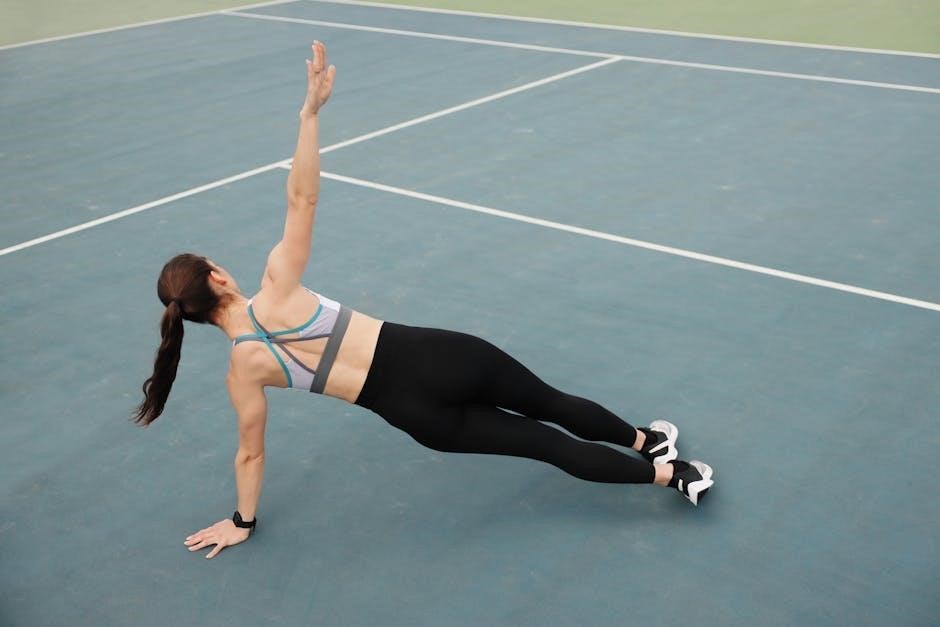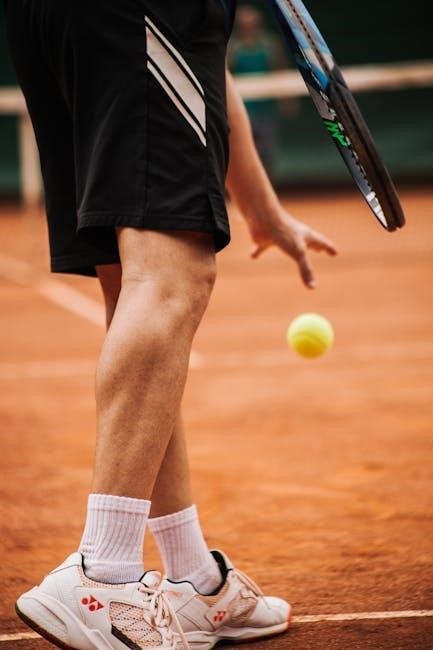Kinesio taping is a non-invasive method using elastic tape to relieve pain and inflammation in tennis elbow, promoting healing and improving circulation.
1.1 What is Tennis Elbow?
Tennis elbow, or lateral epicondylitis, is inflammation of the outer elbow, causing soreness and tenderness. It often results from overuse, repetitive forearm motions, or gripping activities. Common in racquet sports, it leads to pain during gripping, lifting, or twisting. Typically affecting individuals aged 40–60, it disrupts daily activities and sports performance, necessitating effective treatment strategies like Kinesio taping to alleviate symptoms and promote recovery.
1.2 Overview of Kinesio Taping
Kinesio taping is a therapeutic technique using elastic tape to support joints, reduce pain, and improve circulation. It involves applying strips of adhesive tape to specific areas, providing gentle, consistent pressure. This method enhances lymphatic drainage, relaxes muscles, and stabilizes joints without restricting movement. Originating in Japan, it’s widely used in sports and rehabilitation. For tennis elbow, the tape is applied to relieve pressure on inflamed tendons, offering a non-invasive alternative to traditional treatments. Its versatility and ease of use make it a popular choice for managing musculoskeletal conditions.
1.3 Benefits of Kinesio Taping for Tennis Elbow
Kinesio taping offers multiple benefits for tennis elbow, including pain relief, reduced inflammation, and improved circulation. It relaxes overused muscles, stabilizes joints, and enhances lymphatic drainage, promoting faster healing. The tape’s elasticity allows for a full range of motion, making it ideal for active individuals. It also provides sensory feedback, reducing muscle tension and improving joint function. Unlike rigid braces, Kinesio tape is lightweight and breathable, making it comfortable for extended use. These benefits make it a highly effective, non-invasive solution for managing tennis elbow symptoms and supporting recovery.

Causes and Symptoms of Tennis Elbow
Tennis elbow is primarily caused by overuse or repetitive strain on forearm muscles. Symptoms include pain, tenderness, and limited elbow mobility, often worsening with gripping activities.

2.1 Causes of Tennis Elbow
Tennis elbow, or lateral epicondylitis, is primarily caused by overuse or repetitive strain on the forearm muscles and tendons. It often results from activities involving gripping, twisting, or repetitive wrist movements, such as racquet sports or manual labor. Poor technique, inadequate warm-up, or using improper equipment can exacerbate the condition. Additionally, muscle imbalances or weak forearm muscles may contribute to its development. The condition is not exclusive to athletes and can affect individuals performing repetitive tasks, leading to inflammation and pain on the outer elbow.
2.2 Common Symptoms of Tennis Elbow
Tennis elbow typically presents with pain and tenderness on the outer elbow, worsened by gripping, lifting, or twisting motions. Patients often experience soreness when shaking hands, turning a doorknob, or holding objects. Weakness in the forearm and difficulty extending the wrist are common. Morning stiffness and aching after activity may also occur. The pain is usually localized to the lateral epicondyle but can radiate to the forearm. These symptoms can vary in intensity, from mild discomfort to severe pain that limits daily activities and sports performance. Early recognition of these signs is crucial for effective management.

Application Techniques for Kinesio Taping
Kinesio tape is applied using Y or I strips, anchored above the elbow and extended to the forearm or wrist without stretch, relieving tension and pain.
3.1 Step-by-Step Application Guide
Extend the arm, palm down, and gently rotate outward. Anchor the tape above the elbow, extending to just above the wrist without stretch.
Apply a Y-strip over the painful area, stretching the middle section slightly for support.
For additional relief, wrap an I-strip around the elbow, ensuring smooth application without wrinkles.
Rub the tape gently to activate the adhesive. Avoid stretching the ends to maximize comfort and effectiveness.
Ensure the tape is applied on clean, dry skin for optimal adhesion, leaving it on for up to 5 days for continuous support.
3.2 Different Taping Techniques for Tennis Elbow
Several taping techniques are used to address tennis elbow, including the Y-strip, I-strip, and fan application. The Y-strip is applied directly over the painful area, with arms extending toward the wrist and forearm, providing targeted support. The I-strip wraps around the elbow, offering lateral stability. The fan technique involves spreading the tape from the elbow across the forearm to reduce tension. Each method aims to alleviate pain, reduce inflammation, and restore movement. Proper application ensures optimal results, but techniques may vary based on individual needs and severity of the condition.

Scientific Evidence and Research
Research shows Kinesio taping can reduce pain and improve grip strength in tennis elbow, though findings vary, with some studies questioning its efficacy beyond placebo effects.
4.1 Studies on the Effectiveness of Kinesio Taping
Randomized controlled trials have investigated Kinesio taping’s effects on tennis elbow, with mixed results. Some studies report significant reductions in pain intensity and improvements in grip strength, while others find minimal differences compared to sham taping. Research suggests that Kinesio taping may enhance tactile feedback, potentially altering motor responses and reducing muscle tension. However, debates persist regarding its long-term benefits, with some studies concluding that placebo effects may play a role. Overall, the evidence supports Kinesio taping as a adjunctive therapy for tennis elbow, though its efficacy varies among individuals and study designs.
4.2 Immediate Effects on Pain and Function
Studies demonstrate that Kinesio taping can provide immediate relief from pain and improve functional abilities in patients with tennis elbow. Research indicates that the tape’s elastic properties help reduce pressure on inflamed tissues, leading to decreased pain intensity. Grip strength and wrist extension force often show improvement shortly after application. These immediate effects are thought to result from the tape’s ability to enhance proprioceptive feedback, reducing muscle spasms and promoting relaxation. While some studies report significant benefits, others find modest or temporary improvements, suggesting variability in individual responses to this therapeutic intervention.

Case Studies and Real-World Applications
Real-world applications highlight successful outcomes of Kinesio taping in treating tennis elbow, offering relief and improved function. Studies compare its effectiveness with other therapies like physical therapy.
5.1 Successful Outcomes in Treating Tennis Elbow
Studies demonstrate that Kinesio taping significantly reduces pain and improves grip strength in tennis elbow patients. One study revealed a 15% increase in hand grip strength after four weeks of KT application; Patients also reported reduced pain levels during daily activities and sports. The tape’s ability to relieve pressure and enhance circulation contributes to faster recovery. Additionally, Kinesio taping has been shown to be as effective as traditional therapies like ultrasound in improving function. These positive outcomes highlight its value as a non-invasive treatment option for managing tennis elbow effectively. Real-world applications further validate its benefits for both athletes and individuals with chronic elbow pain.
5.2 Comparisons with Other Treatment Methods
Kinesio taping is often compared to traditional treatments like braces, physical therapy, and pain medication for tennis elbow. Studies show that Kinesio taping can be as effective as these methods in reducing pain and improving function. For example, one study found that KT tape provided similar benefits to therapeutic ultrasound in improving grip strength and pain levels. While braces offer more structural support, Kinesio taping allows for greater mobility and comfort. Its non-invasive nature and ability to promote lymphatic drainage make it a popular choice among athletes and individuals seeking alternative therapies for tennis elbow management.

Practical Considerations and Tips
Apply Kinesio tape to clean, dry skin before activity, ensuring no wrinkles. Remove gently with oil, pulling in the direction of hair growth. Avoid stretching tape ends and use heat to activate adhesion for optimal results.
6.1 When to Apply Kinesio Tape
Kinesio tape is best applied before physical activity to prevent strain or during flare-ups to relieve pain and inflammation. It can be used as a preventive measure or as part of a rehabilitation routine. Apply the tape on clean, dry skin, avoiding lotions or oils, to ensure proper adhesion. For optimal results, apply it 30 minutes before activity to allow the adhesive to set. The tape can remain on for up to 5 days, providing continuous support and relief. Regular reapplication may be necessary depending on activity level and comfort needs.
6.2 How to Remove Kinesio Tape Properly
Removing Kinesio tape requires care to avoid skin irritation. Start by peeling the tape slowly from one end, pulling it back towards itself rather than upward. Use an oil-based solution or baby oil to loosen the adhesive, especially if the tape is stubborn. Avoid pulling the tape quickly or yanking it, as this can cause discomfort or skin tears. After removal, clean the skin thoroughly with soap and water. If any residue remains, use an adhesive remover. Proper removal ensures skin health and prevents potential allergic reactions to the tape’s adhesive.

Limitations and Controversies
Kinesio taping lacks robust scientific evidence for long-term benefits, with mixed study results and debates over its true efficacy compared to placebo effects.

7.1 Criticisms of Kinesio Taping
Criticisms of Kinesio taping include limited scientific evidence supporting its long-term benefits, with many studies showing mixed or inconclusive results. Some researchers argue that its effects may be placebo-based, while others highlight the lack of standardized application techniques. Additionally, the tape’s efficacy in addressing underlying tissue damage or inflammation remains unclear. Critics also point out that Kinesio taping may distract from more proven treatments, potentially delaying recovery. These controversies underscore the need for further research to establish its true clinical value for conditions like tennis elbow.
7.2 Mixed Results in Clinical Studies
Clinical studies on Kinesio taping for tennis elbow report inconsistent outcomes. Some research indicates short-term pain relief and improved grip strength, while others find minimal to no difference compared to placebo or traditional treatments. Variability in study designs, application techniques, and outcome measures may contribute to these mixed results. A systematic review highlighted that high-quality evidence supporting its effectiveness is limited, suggesting a need for more rigorous, standardized research to clarify its benefits and optimal use in managing tennis elbow effectively.

Future Directions and Innovations
Future research may focus on advancing Kinesio taping materials, optimizing application techniques, and integrating it with other therapies to enhance tennis elbow treatment outcomes effectively.
8;1 Emerging Trends in Kinesio Taping
Emerging trends in Kinesio taping include advanced materials like waterproof and breathable tapes, improved adhesive properties, and pre-cut designs for specific injuries such as tennis elbow. Additionally, the integration of technology, like smart tapes that monitor movement and provide feedback, is gaining attention. These innovations aim to enhance both comfort and effectiveness, making Kinesio taping a more versatile and accessible option for treating tennis elbow and other musculoskeletal conditions. Researchers are also exploring personalized taping techniques based on individual biomechanics and pain patterns.
8.2 Potential Advances in Tennis Elbow Treatment
Potential advances in tennis elbow treatment include combining Kinesio taping with therapeutic modalities like ultrasound or vibration therapy to enhance recovery. Researchers are exploring personalized taping techniques tailored to individual biomechanics and pain patterns. Additionally, innovations in tape materials, such as enhanced adhesive properties and breathable designs, may improve comfort and durability. Studies suggest that integrating Kinesio taping with exercise programs could further boost grip strength and reduce pain intensity. These advancements aim to provide more effective, non-invasive solutions for managing tennis elbow, though further research is needed to confirm long-term benefits and optimal application methods.
Kinesio taping offers a promising, non-invasive approach to managing tennis elbow, providing pain relief and improving function, though further research is needed to confirm its long-term benefits.
9.1 Summary of Key Findings
Kinesio taping for tennis elbow has shown potential in reducing pain and improving function, with immediate benefits like enhanced grip strength and reduced discomfort. The tape works by relieving pressure, relaxing muscles, and improving circulation. While some studies highlight its effectiveness, others report mixed results, suggesting limited long-term benefits. Proper application techniques, such as placing tape around the elbow and forearm, are crucial for optimal outcomes. Overall, Kinesio taping remains a popular, non-invasive option for managing tennis elbow, though further research is needed to confirm its efficacy and establish standardized protocols for application.
9.2 Final Thoughts on Kinesio Taping for Tennis Elbow
Kinesio taping offers a promising, non-invasive approach for managing tennis elbow, providing immediate pain relief and functional improvement. Its ability to enhance circulation and reduce muscle tension makes it a valuable adjunct to traditional therapies. However, while some studies support its benefits, others highlight inconsistent results, indicating the need for further research. Despite this, many patients and practitioners find it a useful tool for symptom management. For optimal results, proper application techniques and individualized treatment plans are essential. Kinesio taping remains a practical and accessible option for those seeking complementary care for tennis elbow.